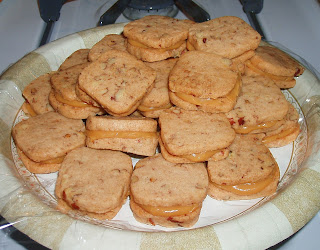My Favorite Cream Cheese Pound Cake - first made November 2007 from Sticky Messy Chewy Gooey
That's what this recipe is literally called, not that I'm calling it my favorite cream cheese pound cake. Truth be told, I've only made 2 cream cheese pound cakes and the other one is the entry just before this one. I thought I'd post this one in case anyone wanted to do any comparative baking and taste testing. However, between the two, I do have to give the nod to this recipe. It's richer and (to me) has more flavor, probably because it's got a hefty 50% more butter than the other recipe. The toothpick test works well for this one when you're testing for doneness. It tastes great warm (most things do) but is also great at room temperature. Don't refrigerate this as that'll dry it out. If you need to store it because you aren't going to eat it all within a couple of days - and the consumption of anything with this much butter in it should be spaced out - then wrap it in foil or a freezer bag and put in the freezer.
While this is richer, I wouldn't say the cream cheese is overpowering in flavor. It's actually quite subtle. I suspect the cream cheese helps with the excellent texture this has but if you're like me and aren't wild about the taste of cream cheese, this is a safe pound cake to make.
1 ½ cups (3 sticks) unsalted butter, at room temperature
8 ounces cream cheese, at room temperature
3 cups sugar
½ teaspoon salt
2 teaspoons pure vanilla extract
6 large eggs, at room temperature
3 cups bleached all-purpose flour, sifted then measured
3 cups bleached all-purpose flour, sifted then measured
1 teaspoon baking powder
1. Position a rack in the middle of the oven and preheat to 325˚F. Spray two 8 ½ by 4 ½” loaf pans with nonstick cooking spray.
2. Beat the butter and cream cheese together in a large bowl, with an electric mixer until smooth and creamy. With the mixer running, gradually add the sugar and continue beating until pale and fluffy. Beat in the salt and vanilla.
3. Add the eggs to the butter mixture one at a time, beating well after each addition. Sift the flour again along with the baking powder into the batter and, using a large rubber spatula, fold in until no traces of flour remain and the batter is smooth.
4. Divide the batter between the two prepared loaf pans. Bake until the tops are golden and slightly cracked, and when a skewer inserted into the center of the cakes comes out with only a few moist crumbs clinging to it, 60 to 75 minutes. Transfer to a wire rack and let cool in the pans for 10 minutes, then turn the cakes out of the pans and let cool to room temperature on the wire rack before serving.
5. At this point the cakes can be wrapped well in plastic wrap and stored at room temperature for up to 3 days or frozen for up to 1 month.












